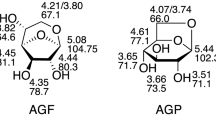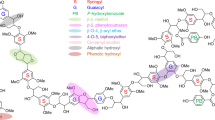Abstract
Carbohydrate conversion offers access to a variety of chemicals with diverse functionalities. An accurate analysis of the multiple products in post-reaction material is indispensable for enabling good atom economy in biorefining. A certain need for reconsidering current analytical approaches to chemocatalytic biomass conversion is witnessed by the often poor carbon balances that are reported for carbohydrate conversion processes. Carbohydrate conversion usually includes isomerization and/or dehydration, therefore analytical approaches that are suitable for the distinction and concurrent quantification of isomers are desirable for developing sustainable processes towards known and new chemicals. Quantitative 1D NMR spectroscopy can be used to determine absolute concentrations in the absence of purified reference compounds and can thereafter be used to obtain response factors in other analytical methods resolving the compounds of interest. Here, we show that this approach is applicable for obtaining response factors relative to an internal standard for rapid, highly resolved 2D NMR spectra at natural isotopic abundance. Following calibration, this approach provides a limit of quantification in the order of 0.8 mM within an experiment time of a few minutes. The approach is particularly beneficial for the quantification of compounds at low concentrations, for instance in initial rate experiments, and for the quantification of low populated reaction intermediates.










Similar content being viewed by others
References
Cherubini F (2010) The biorefinery concept: Using biomass instead of oil for producing energy and chemicals. Energy Convers Manag 51(7):1412–1421
Kokossis AC, Yang A (2010) On the use of systems technologies and a systematic approach for the synthesis and the design of future biorefineries. Comput Chem Eng 34(9):1397–1405
Moreau C, Durand R, Razigade S, Duhamet J, Faugeras P, Rivalier P, Ros P, Avignon G (1996) Dehydration of fructose to 5-hydroxymethylfurfural over H-mordenites. Appl Catal A 145(1):211–224
Dusselier M, Mascal M, Sels BF (2014) Top chemical opportunities from carbohydrate biomass: a chemist’s view of the biorefinery. In: Nicholas KM (ed) Selective catalysis for renewable feedstocks and chemicals. Springer, Cham, pp 1–40
Antal MJ, Mok WSL, Richards GN (1990) Mechanism of formation of 5-(hydroxymethyl)-2-furaldehyde from d-fructose and sucrose. Carbohyd Res 199(1):91–109
Holm MS, Saravanamurugan S, Taarning E (2010) Conversion of sugars to lactic acid derivatives using heterogeneous zeotype catalysts. Science 328(5978):602–605
Moliner M, Roman-Leshkov Y, Davis ME (2010) Tin-containing zeolites are highly active catalysts for the isomerization of glucose in water. Proc Natl Acad Sci USA 107(14):6164–6168
Zhao H, Holladay JE, Brown H, Zhang ZC (2007) Metal chlorides in ionic liquid solvents convert sugars to 5-hydroxymethylfurfural. Science 316(5831):1597
Choudhary V, Mushrif SH, Ho C, Anderko A, Nikolakis V, Marinkovic NS, Frenkel AI, Sandler SI, Vlachos DG (2013) Insights into the interplay of lewis and brønsted acid catalysts in glucose and fructose conversion to 5-(hydroxymethyl)furfural and levulinic acid in aqueous media. J Am Chem Soc 135(10):3997–4006
Tolborg S, Meier S, Sádaba I, Elliot SG, Kristensen SK, Saravanamurugan S, Riisager A, Fristrup P, Skrydstrup T, Taarning E (2016) Tin-containing silicates: identification of a glycolytic pathway via 3-deoxyglucosone. Green Chem 18(11):3360–3369
Markley JL, Brüschweiler R, Edison AS, Eghbalnia HR, Powers R, Raftery D, Wishart DS (2017) The future of NMR-based metabolomics. Curr Opin Biotechnol 43:34–40
Hollis DP (1963) Quantitative analysis of aspirin, phenacetin, and caffeine mixtures by nuclear magnetic resonance spectrometry. Anal Chem 35(11):1682–1684
Forseth RR, Schroeder FC (2011) NMR-spectroscopic analysis of mixtures: from structure to function. Curr Opin Chem Biol 15(1):38–47
Elliot SG, Tolborg S, Sádaba I, Taarning E, Meier S (2017) Quantitative NMR approach to optimize the formation of chemical building blocks from abundant carbohydrates. ChemSusChem 10(14):2990–2996
Kostidis S, Addie RD, Morreau H, Mayboroda OA, Giera M (2017) Quantitative NMR analysis of intra- and extracellular metabolism of mammalian cells: a tutorial. Anal Chim Acta 980:1–24
Lerche MH, Yigit D, Frahm AB, Ardenkjaer-Larsen JH, Malinowski RM, Jensen PR (2018) Stable isotope-resolved analysis with quantitative dissolution dynamic nuclear polarization. Anal Chem 90(1):674–678
Mutlib A, Espina R, Atherton J, Wang J, Talaat R, Scatina J, Chandrasekaran A (2012) Alternate strategies to obtain mass balance without the use of radiolabeled compounds: application of quantitative fluorine (19F) nuclear magnetic resonance (NMR) spectroscopy in metabolism studies. Chem Res Toxicol 25(3):572–583
Simmler C, Napolitano JG, McAlpine JB, Chen SN, Pauli GF (2014) Universal quantitative NMR analysis of complex natural samples. Curr Opin Biotechnol 25:51–59
Sette M, Wechselberger R, Crestini C (2011) Elucidation of lignin structure by quantitative 2D NMR. Chemistry 17(34):9529–9535
Yan J, Kiemle D, Liu S (2015) Quantification of xylooligomers in hot water wood extract by 1H-13C heteronuclear single quantum coherence NMR. Carbohydr Polym 117:903–909
Bøjstrup M, Petersen BO, Beeren SR, Hindsgaul O, Meier S (2013) Fast and accurate quantitation of glucans in complex mixtures by optimized heteronuclear NMR spectroscopy. Anal Chem 85(18):8802–8808
Li X, Hu K (2017) Chapter three—quantitative NMR studies of multiple compound mixtures. In: Webb GA (ed) Annual reports on NMR spectroscopy, vol 90. Academic Press, London, pp 85–143. https://doi.org/10.1016/bs.arnmr.2016.08.001
Do NM, Olivier MA, Salisbury JJ, Wager CB (2011) Application of quantitative 19F and 1H NMR for reaction monitoring and in situ yield determinations for an early stage pharmaceutical candidate. Anal Chem 83(22):8766–8771
Rundlof T, Mathiasson M, Bekiroglu S, Hakkarainen B, Bowden T, Arvidsson T (2010) Survey and qualification of internal standards for quantification by 1H NMR spectroscopy. J Pharm Biomed Anal 52(5):645–651
Rundlof T, McEwen I, Johansson M, Arvidsson T (2014) Use and qualification of primary and secondary standards employed in quantitative (1)H NMR spectroscopy of pharmaceuticals. J Pharm Biomed Anal 93:111–117
Elliot SG, Taarning E, Madsen R, Meier S (2018) NMR spectroscopic isotope tracking reveals cascade steps in carbohydrate conversion by tin-beta. ChemCatChem 10(6):1414–1419
Elliot SG, Tolborg S, Madsen R, Taarning E, Meier S (2018) Effects of alkali-metal ions and counter ions in Sn-beta-catalyzed carbohydrate conversion. ChemSusChem 11(7):1198–1203
Saravanamurugan S, Tosi I, Rasmussen K, Jensen R, Taarning E, Meier S, Riisager A (2017) Facile and benign conversion of sucrose to fructose using zeolites with balanced Brønsted and Lewis acidity. Catal Sci Technol 7:2782–2788
Tosi I, Riisager A, Taarning E, Jensen P, Meier S (2018) Kinetic analysis of hexose conversion to methyl lactate by Sn beta: effects of substrate masking and of water. Catal Sci Technol 8:2137–2145
Cullen CH, Ray GJ, Szabo CM (2013) A comparison of quantitative nuclear magnetic resonance methods: internal, external, and electronic referencing. Magn Reson Chem MRC 51(11):705–713
Le Gresley A, Fardus F, Warren J (2015) Bias and uncertainty in non-ideal qNMR analysis. Crit Rev Anal Chem 45(4):300–310
Elliot SG, Andersen C, Tolborg S, Meier S, Sádaba I, Daugaard AE, Taarning E (2017) Synthesis of a novel polyester building block from pentoses by tin-containing silicates. RSC Adv 7(2):985–996
Webster GK, Marsden I, Pommerening CA, Tyrakowski CM, Tobias B (2009) Determination of relative response factors for chromatographic investigations using NMR spectrometry. J Pharm Biomed Anal 49(5):1261–1265
Petersen BO, Hindsgaul O, Meier S (2014) Profiling of carbohydrate mixtures at unprecedented resolution using high-precision 1H-13C chemical shift measurements and a reference library. Analyst 139(2):401–406
Malz F, Jancke H (2005) Validation of quantitative NMR. J Pharm Biomed Anal 38(5):813–823
Vitorge B, Jeannerat D (2006) NMR diffusion measurements in complex mixtures using constant-time-HSQC-IDOSY and computer-optimized spectral aliasing for high resolution in the carbon dimension. Anal Chem 78(15):5601–5606
Njock GB, Pegnyem DE, Bartholomeusz TA, Christen P, Vitorge B, Nuzillard JM, Shivapurkar R, Foroozandeh M, Jeannerat D (2010) Spectral aliasing: a super zoom for 2D-NMR spectra. Principles and applications. Chimia 64(4):235–240
Kazimierczuk K, Orekhov VY (2011) Accelerated NMR spectroscopy by using compressed sensing. Angew Chem Int Ed 50(24):5556–5559
Acknowledgements
This work was funded by the Innovation Fund Denmark (Case Number 5150-00023B). 800 MHz NMR spectra were recorded by using the spectrometer of the NMR center DTU supported by the Villum foundation.
Author information
Authors and Affiliations
Corresponding authors
Additional information
Publisher’s Note
Springer Nature remains neutral with regard to jurisdictional claims in published maps and institutional affiliations.
Electronic supplementary material
Below is the link to the electronic supplementary material.
Rights and permissions
About this article
Cite this article
Elliot, S.G., Tosi, I., Riisager, A. et al. Response Factors Enable Rapid Quantitative 2D NMR Analysis in Catalytic Biomass Conversion to Renewable Chemicals. Top Catal 62, 590–598 (2019). https://doi.org/10.1007/s11244-019-01131-y
Published:
Issue Date:
DOI: https://doi.org/10.1007/s11244-019-01131-y




